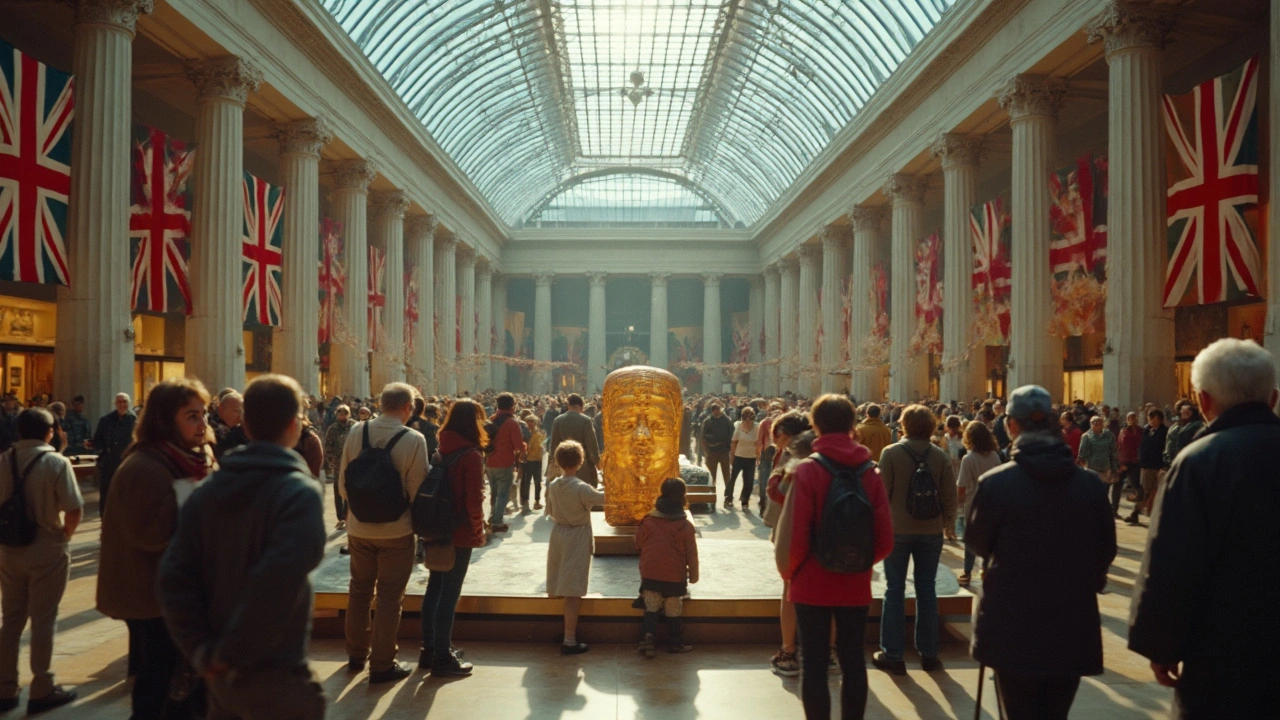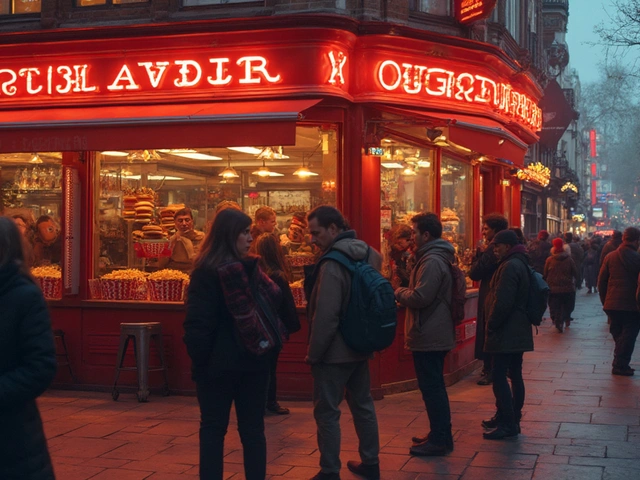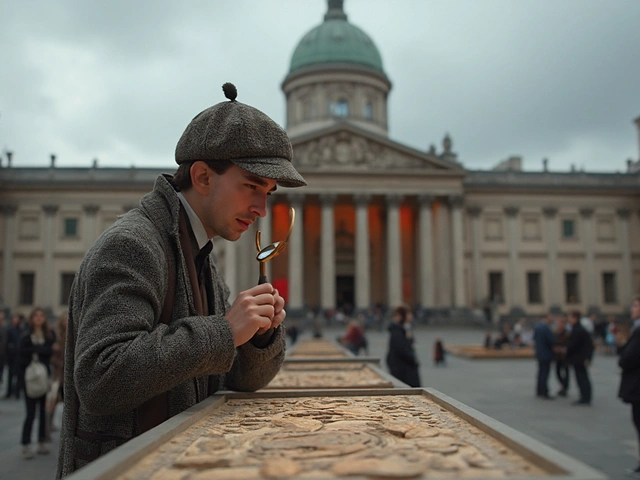
You don’t have to be a history buff to get hooked at London’s British Museum. Sitting right in the heart of Bloomsbury, this place is a staple for locals, students from nearby UCL, and anyone wandering through central London after a coffee in Russell Square. The bonus? Entry is free, so you can pop in for half an hour between meetings or spend your entire Saturday soaking up stories from ancient Egypt to Victorian Britain.
Getting there is easy. Hop off at Tottenham Court Road or Holborn on the Tube, and you'll be at the museum’s grand entrance within minutes. If you’re cycling, there’s bike parking on Great Russell Street—just don’t forget to bring your own lock. And for parents, there are buggy-friendly routes inside, plus lots of free cloakroom space for backpacks and coats.
First time visiting? Grab a museum map near the front entrance or use their handy app—it saves you getting lost in the maze of galleries. The Rosetta Stone and the Elgin Marbles are obvious showstoppers, but there’s plenty more tucked away if you’re looking to escape the crowds. Try heading to the African galleries or the Japan section in the morning for a quieter wander. On Fridays, the museum stays open late, so it's a solid spot to visit after work if you want to avoid the daytime rush.
- Making the Most of Your British Museum Visit
- Must-See Highlights Beyond the Obvious
- Insider Tips from Locals
- Getting Involved: Tours, Workshops, and Family Fun
- Around the Museum: Eats, Shops, and Hidden Gems in Bloomsbury
Making the Most of Your British Museum Visit
If you’re in London and haven’t dropped by the British Museum yet, you’re seriously missing out. This spot isn’t just for tourists clutching travel guides—it’s a favourite hangout for Londoners too. Let’s get you sorted for your next visit, whether you’re going solo, with the family, or sneaking in a quick lunchtime wander.
The British Museum opens daily from 10am to 5pm, but you’ll find it a bit quieter right after opening and in the late afternoons, especially on Fridays when it runs until 8:30pm. If you want prime photo ops minus the crowds, get in early (just after opening) or save your trip for later in the day.
Now, most folks make a beeline straight for the Rosetta Stone and wind up in a dense pack of smartphone-clutching visitors. Instead, pick up a free paper map or download the museum’s app before you go. There’s free WiFi, so streaming the audio tours or checking layouts is easy. Pro-tip: head up to the less crowded upper galleries—like the Americas, or Ancient Iran—where you can usually get a bench to yourself (great for a quiet moment or jotting down notes).
- Bag Checks: Security is swift but expect to get your bag checked at the entrance. Ditch bulky bags if you can—they slow you down.
- Lockers: There are self-service lockers in the basement (fees from £2). Handy for stashing umbrellas or small suitcases.
- Family Visits: Baby changing and feeding rooms are available, and you can borrow strollers if you forgot yours.
- Accessibility: Most areas are wheelchair-friendly, and you can pre-book wheelchairs if your nan’s coming along.
- Photography: Non-flash photos are fine in most galleries, but watch for signs. No tripods though—save those for a walk around Bloomsbury’s leafy squares.
And don’t get caught out by school trips or summer holidays when the museum can get rammed, especially in the Egyptian and Greek sections. Lunchtimes on weekends are peak hours, so time your visit for mid-morning or later in the afternoon if you want some breathing space.
Fast facts to help you plan:
| Opening Hours | Admission | Nearest Tube | Annual Visitors |
|---|---|---|---|
| Mon-Sun: 10am-5pm Fri: until 8:30pm | Free (special exhibitions may charge) | Tottenham Court Road Holborn | Over 6 million |
For special exhibitions, booking ahead online is a must—tickets can sell out fast, especially for blockbusters like Ancient Egypt or Celtic Britain. Locals often get first dibs on preview tickets, so sign up to the museum’s newsletter to stay in the loop. Finally, don’t forget to stop at the Great Court Café for a quick sandwich or a cuppa—perfect fuel for exploring just one more room!
Must-See Highlights Beyond the Obvious
Sure, everyone talks about the Rosetta Stone and the Egyptian mummies at the British Museum. But there are hundreds of other treasures here that locals usually recommend skipping the main crowds for. If you want to see something different, start at the Sutton Hoo collection in Room 41. It’s a real find for anyone keen on British history—this early medieval ship burial is packed with gold, helmets, and everyday items from when Anglo-Saxons ruled the land. School kids love this section, and it really gives you a sense of life in England over a thousand years ago.
Head upstairs to check out the Assyrian Lion Hunt reliefs in Room 10b. These massive stone panels once decorated a king’s palace in ancient Iraq—look out for the fine detail showing each lion’s movement. It’s actually easy to miss these if you stick to the main ground floor, and they’re way less crowded than the headline exhibitions.
If Japan grabs your attention, the Japan Gallery in Room 92 is where you’ll spot kimonos, samurai armour, and quirky ceramics. Friday nights, you’ll sometimes find special pop-up talks here with local artists or historians. It’s worth checking the website beforehand.
Another useful tip: don’t skip the Africa galleries in Rooms 25 and 26. Here, you’ll see the Benin Bronzes—a talking point in any London pub conversation about colonial history. The craftsmanship is mind-blowing, and the ongoing debates about returning artefacts make this section a bit of a hotspot for anyone interested in ethical questions around museum collections.
If you’re with little ones, try the Enlightenment Gallery. This was the original British Museum room and feels like a time capsule, filled with weird and wonderful odds and ends picked up by collectors. There are plenty of hands-on bits and touchable artefacts—great for fidgety kids or breakaway moments between the blockbuster displays.
- Best time for these galleries? Mornings during the week or after 4pm, when tour groups clear out.
- Don’t rely on just the main entrance—look for side doors if you want a shortcut to quieter rooms.
- Check out the museum’s schedule for pop-up talks or mini-exhibits, especially during holidays when the place gets lively.
So, next time you visit, skip the obvious and give these hidden gems a try—you'll see a whole new side of London’s most famous museum.

Insider Tips from Locals
If you've ever chatted to someone who works near Bloomsbury or grew up in London, you’ll know the real tricks to getting the best out of the British Museum. Locals steer clear of the massive crowds that roll in around midday, especially on weekends and school holidays. The quietest times are usually weekday mornings right after opening (10am), or late Friday evenings when the museum stays open until 8:30pm.
Don’t just rely on the main entrance on Great Russell Street. The north Montague Place entrance is often faster with shorter queues. The security team is friendly but thorough, so pack light to get through bag checks quicker. If you're after a calm spot to recharge, the Ford Centre for Young Visitors isn’t just for school trips—adults can duck in to use the sofas and wifi.
Food-wise, skip the pricy main café and try the smaller Court Café in the Great Court for decent sarnies and less queueing. But honestly, most locals pop out to Sicilian Avenue for a Greggs or pick up sushi from Wasabi across the road.
For those who love lists, here’s how Londoners like to squeeze the most out of a visit:
- Pick a theme (like Roman coins or mummies) instead of trying to see everything in one day.
- Download the free BM App—there’s a good audio guide and some fun quests for kids and adults.
- Check the museum website before you go for any pop-up talks or workshops—they’re often first-come, first-served and easy to miss if you’re not looking.
- The family desks hand out paper trails—a low-tech but fun way to focus restless kids (or adults who love a scavenger hunt).
- Don’t miss Room 33 (Asia), which feels peaceful even in the busiest season.
If you’re planning ahead or showing friends around, save yourself some stress with these quick need-to-knows:
| Top Local Tip | The Payoff |
|---|---|
| Montague Place entrance | Less queueing, faster in and out |
| Arrive before 11am or after 4pm | Space to breathe, no selfie sticks in the way |
| Skip the crowd magnets | Hidden gems without dodging tour groups |
| Bring your own bottle | Water refill points near main toilets—save pennies |
And finally, don’t bother paying for the cloakroom unless you’re carrying something heavy. Most regular bags are allowed inside. Just don’t bring food with you—it’s not allowed in the galleries.
Getting Involved: Tours, Workshops, and Family Fun
Sticking to a self-guided wander is great, but jumping into the British Museum’s official tours and workshops makes the whole thing way more hands-on. For starters, their free “Eye Opener” tours run every day—no need to book, just show up at the right gallery and let the experts take you behind the scenes of everything from ancient Greece to Egyptian mummies. For paid options, the “Highlights” tour (£15 for adults) is a fast-track way to check out the big-ticket items and hear real stories you’d never get from a sign on the wall.
If you’ve got kids, don’t miss the “Little Explorers” backpacks, which are packed with cool activities for different age groups. You just grab one at the Family Desk in the Great Court and return it before you leave. During half term or school holidays, look out for extra pop-up workshops where children can make crafts or handle real museum objects.
“The museum isn’t just for looking at old stuff; it’s about getting your hands dirty and sparking new ideas,” says Natalie Haynes, BBC Radio 4 broadcaster and author.
- British Museum volunteer-led tours: Free, 30–40 minutes, available daily
- Family-friendly storytelling sessions: Saturdays and school holidays, included with entry
- Creative workshops: Typical fees £5–£10, check online calendar
- Kids’ backpacks: Free, pick up early (they go fast on weekends)
Teens and curious adults might enjoy talks or debates on hot topics like AI in archaeology or the future of museums. You can also take part in “Object Handling” sessions—yes, you actually get to touch artefacts from different periods, with experts right there to answer questions.
Here’s a quick look at what’s usually running throughout the year:
| Activity | Who It’s For | When | Cost |
|---|---|---|---|
| Guided Tours | Adults & families | Daily | Free or £15 |
| Workshops | Kids & teens | Weekends, holidays | £5–£10 |
| Object Handling | All ages | Selected days | Free |
| Storytelling | Young children | Saturdays | Free |
Keep an eye on the museum’s website or ask at the main entrance, because dates and timings shift through the year. It’s easy to fill a whole afternoon here, especially if the London weather sends you running for cover indoors.

Around the Museum: Eats, Shops, and Hidden Gems in Bloomsbury
Stepping out of the British Museum, you’ll find yourself in the heart of Bloomsbury—a neighbourhood packed with casual cafés, quirky bookshops, and peaceful squares where Londoners take their lunch breaks. If you need a refuel, The Great Court Restaurant inside the museum serves up classic afternoon tea and British dishes. For a more laid-back bite, walk just around the corner to Store Street Espresso, a favourite for strong coffee and fresh pastries, or grab a falafel wrap from Gails Bakery on Tottenham Court Road.
If you’re shopping for souvenirs, skip the usual fridge magnets and check out the museum’s gift shop for unique finds like handmade jewellery and history-inspired toys. For book lovers, Skoob Books on Brunswick Square is a basement treasure trove filled with secondhand gems—they often have out-of-print travel guides and old art books you won’t spot elsewhere.
Need a bit of quiet? Russell Square is a short walk away and perfect for a picnic or just stretching out on the grass. In spring, the cherry blossoms are unbeatable for a lunch break escape. Nearby, the Charles Dickens Museum lets you peek inside the writer’s actual home if you’re after even more London history (and it’s usually less crowded than the main museum).
Bloomsbury’s lanes are also known for independent shops selling everything from vinyl to vintage scarves. The London Review Bookshop is a top pick for anyone who loves to browse with a cup of tea—their cake selection is legendary with locals. So if you’re planning a full day around the museum, don’t be afraid to wander and see what you stumble across. Between the art, the food, and a few hidden corners, Bloomsbury always has something worth discovering.






